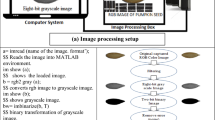Abstract
The present study was undertaken to investigate engineering properties (viz. mass, density, volume, porosity, surface area, specific surface area, coefficient of friction, angle of repose, mechanical properties and colour) and chemical characteristics (moisture, oil and protein content) of Karanj (Pongamia pinnata) seeds and kernels. The length (l), width (w) and thickness (t) values indicated that the kernels are more spherical than the seeds. Average sphericity values of seeds and kernels were, 0.42 and 0.63, respectively. Although bulk densities did not vary, the true density of kernels was almost 2.5 times that of seeds. Kernels exhibited less coefficient of friction compared to seeds over different surfaces. Oil and protein content of kernels were found to be 35 and 18%, respectively. Mechanical properties in terms of rupture force (RF, N), hardness (H, N mm−1), deformation (RD, mm) and energy for rupture (ER, N mm) were measured. While RF and ER were marginally more for seeds, kernels were harder as registered from the H values. Pearson correlation coefficient indicated high (r = 0.847 at p < 0.001) correlation between t and unit weight (wt) of seeds. Statistically significant (R2 > 0.9, p < 0.001) linear models could also be developed for kernels with t and wt as dependent variables, respectively.






Similar content being viewed by others
References
AOAC (1990) Official methods of analysis, 15th edn. Association of Official Analytical Chemists, Washington
Bahnasawy AH (2007) Some physical and mechanical properties of garlic. Int J Food Eng 3:1–18
Bozkurt H, Bayram M (2006) Colour and textural attributes of sucuk during ripening. Meat Sci 73:344–350
Brijesh S, Daswani PG, Tetali P, Rojatkar SR, Antia NH, Birdi TJ (2006) Studies on Pongamia pinnata (L.) Pierre leaves: understanding the mechanism(s) of action in infectious diarrhoea. J Zhejiang Univ Sci B 7:665–674
FAO (2015) Food and Agriculture Organization of United Nations. http://www.fao.org/forestry/nwfp/6388/en/. Accessed 24 Dec 15
IUPAC (1992) Standard methods for the analysis of oils, fats and derivaties. In: Paquot C, Hautffenne A (eds) International union of pure and applied chemistry, 7th edn. Blackwell Scientific Publications Inc, Oxford
Ixtaina VY, Nolasco SM, Tomas MC (2008) Physical properties of chia (Salvia hispanica L.) seeds. Ind Crop Prod 28:286–293
Joshi S (2003) Super market, secretive. Exploitative, is the market in the minor forest produce unmanageable? Down Earth 28:27–34
Kachru RP, Gupta RK, Alam A (1994) Physico-chemical constituents and engineering properties of food crops. Scientific Publishers, Jodhpur
Karaj S, Müller J (2010) Determination of physical, mechanical and chemical properties of seeds and kernels of Jatropha curcas L. Ind Crop Prod 32:129–138
Kesari V, Das A, Rangan L (2010) Physico-chemical characterization and microbial assay from seed oil of Pongamia pinnata, potential biofuel crop. Biomass Bioenergy 34:108–115
Maduako JN, Faborode MO (1990) Some physical properties of cocoa pods in relation to primary processing. Ife J Technol 2:1–7
Mahapatra AK, Shackleton CM (2011) Has deregulation of non-timber forest product controls and marketing in Orissa state. For Policy Econ 13:622–629
Majhi A, Sharma YK, Naik DV (2012) Blending optimization of Hempel distilled bio-oil with commercial diesel. Fuel 96:264–269
Meera B, Kumar S, Kalidhar SB (2003) A review of the chemistry and biological activity of Pongamia pinnata. J Med Arom Plant Sci 25:441–465
Metzger LE, Barbano DM, Rudan MA, Kindstedt PS, Guo MR (2000) Whiteness change during heating and cooling of Mozzeralla cheese. J Dairy Sci 83:1–10
Mohsenin NN (1980) Physical properties of plant and animal materials: structure, physical characteristics and mechanical properties. Gordon and Breach Science Publishers, New York
Ndayishimiye P, Tazerout M (2011) Use of palm oil-based biofuel in the internal combustion engines: performance and emissions characteristics. Energy 36:1790–1796
No SY (2011) Inedible vegetable oils and their derivatives for alternative diesel fuels in CI engines: a review. Renew Sustain Energy Rev 15:131–141
Padhi SK, Singh RK (2011) Non-edible oils as the potential source for the production of biodiesel in India: a review. J Chem Pharm Res 3:39–49
Rajendra M, Jena PC, Raheman H (2009) Prediction of optimized pre-treatment process parameters for biodiesel production using ANN and GA. Fuel 88:868–875
Rich EC, Teixeira AA (2005) Physical properties of Mucuna (velvet) bean. Appl Eng Agric 21:437–443
Scott PT, Pregelj L, Chen N, Hadler JS, Djordjevic MA, Gresshoff PM (2008) Pongamia pinnata: an untapped resource for the biofuels industry of the future. Bioenergy Res 1:2–11
Shoba GF, Thomas M (2001) Study of anti-diarrhoeal activity of four medicinal plants in castor-oil induced diarrhoea. J Ethnopharmacol 76:73–76
Singh KK, Goswami TK (1996) Physical properties of cumin seed. J Agric Eng Res 64:93–98
Sirisomboon P, Kitchaiya P, Pholpho T, Mahuttanyavanitch W (2007) Physical and mechanical properties of Jatropha curcas L. fruits, nuts and kernels. Biosyst Eng 97:201–207
Wickens GE (1994) Sustainable management for non-wood forest products in the tropics and subtropics. In: Readings in sustainable forest management. FAO, Rome, pp 55–65
Willmut CJ (1982) Some comments on the evaluation of model performance. Bull Am Meteorol Soc 63:1309–1313
WRI (World Resources Institute) (2015) Climate Analysis Indicators Tool (CAIT) 2.0: WRI’s climate data explorer. 2014. Accessed June. http://cait.wri.org
Acknowledgements
The authors wish to acknowledge the efforts of Regional Manager, TRIFED, Bhopal, India, for the voluntary contribution of Pongamia pinnata seeds. The assistance received from the Biochemistry Laboratory, Agro Produce Processing Division, ICAR-Central Institute of Agricultural Engineering, Bhopal, India, is also duly acknowledged.
Author information
Authors and Affiliations
Corresponding author
Rights and permissions
About this article
Cite this article
Chakraborty, S.K., Chandel, N.S., Kotwaliwale, N. et al. Characterisation of Properties for Karanj (Pongamia pinnata) Seeds and Kernels in Relation to Bulk Handling and Processing Applications. Agric Res 7, 280–289 (2018). https://doi.org/10.1007/s40003-018-0319-5
Received:
Accepted:
Published:
Issue Date:
DOI: https://doi.org/10.1007/s40003-018-0319-5




